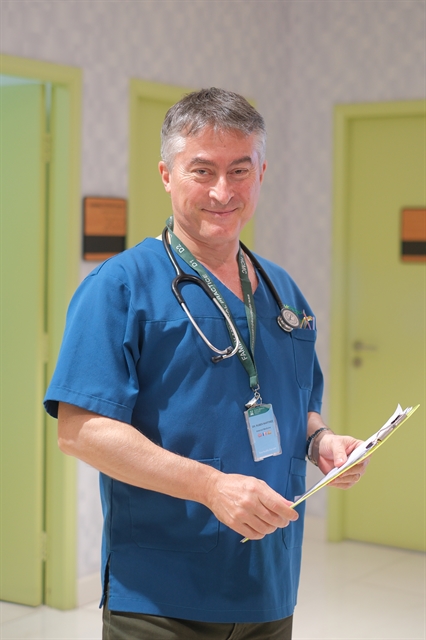Wound Care Essentials: Understanding, Treating, and Healing
Culture - Ngày đăng : 10:54, 30/09/2024
.jpg) |
| Doctor arranges hand bondage for patient. Photo freepik.com |
Dr Ruben Martinez *
A wound is a disruption of the skin from an external physical aggression, either pressure, traction, burn, punch, cut or friction. In wound care, many medical care practices rely more on tradition than on scientific evidence. Proper cleaning and dressing are essential for faster recovery.
Are alcohol or peroxide solutions ideal for cleaning wounds? Should blisters from burns be popped? Do oozing or dry wounds need a different dressings approach? Should antibiotic cream be applied to burns? What is slough? Does it mean infection?
Even some healthcare professionals unfamiliar with wound care may have these questions.
Wound care begins with evaluating the patient, considering factors like medical conditions, medications and lifestyle. Following this, the wound should be assessed using the TIME framework:
T: Tissue viability: Wound tissue can be necrotic, crushed, crusted, blistered or viable. In some cases, debridement may be needed to remove dead tissue. Burns and wounds are dynamic conditions that require frequent reassessment.
I: Infection/inflammation: Not all wounds are infected from the beginning. Inflammation is the body's response to healing, and should not be confused with infection. Early and abundant sterile saline water wash with chlorhexidine gel is the best first measure against infection.
M: Moisture balance: Wounds go through several phases, starting by oozing and ending with dryness. Dressings should be adjusted to match these stages.
E: Edge of the wound: The size and condition of the wound edge impact healing. The surrounding skin care is equally important as to care about other coincident skin conditions like leg oedema, eczema, psoriasis or diabetic foot.
Wound cleaning protocol:
Clean the wound and the surrounding area (30cm) with chlorhexidine 4 per cent gel and rinse with saline. Avoid using alcohol, peroxide, or betadine. Dirty wounds may need 500 to 1000ml saline with a pressure jet system.
Mechanical wounds includes:
1) Abrasions: Superficial injuries normally caused by friction between the skin and a blunt object. These wounds often heal without scarring.
2) Cuts: Sharp-edged wounds needing closure with sutures or adhesives. At Family Medical Practice, we do not use skin adhesives in areas of skin tension or high mobility, like the face, where a linear cut can behave as a laceration (the inferior part of the wound is displaced down by gravity, and the glue will fall inside and delay the healing).
3) Lacerations: Jagged wounds caused by blunt instruments or force. They often have necrotic edges and need regular evaluation.
4) Penetrating wounds: Caused by sharp objects, these carry a higher risk of infection due to difficulty in cleaning.
5) Bites: Animal or human bites combine characteristics of abrasions, lacerations, and penetrating wounds. These need thorough cleaning, and sometimes the wound is left open to be washed and redressed daily.
Burns:
Burns are caused by thermal, chemical, electrical, or radiation sources and are classified based on the depth of skin damage:
- Superficial burns affect the outer skin layers.
- Deep dermal burns destroy most of the skin's surface layers.
- Full thickness burns damage all skin layers.
Each type requires different treatment approaches and has different recovery times.
For chemical burns, those from alkalis are more severe than burns from acids and need immediate full-body rinsing. Electrical burns should be referred to a hospital as they can affect the whole nerve and produce deep injuries far from the point of contact (full arm or more).
Chronic wounds:
Wounds that don't heal within three months are classified as chronic and can cause significant emotional, physical, and financial stress on patients and the whole health care system. Common examples include pressure ulcers, diabetic wounds, and leg ulcers.
At Family Medical Practice, our multispecialty team of doctors and nurses familiar with wound care to ensure timely and effective management. Don't underestimate a wound - seek professional care early for the best treatment. Family Medical Practice
 |
| Dr. Ruben Martinez. Photo courtesy of Family Medical Practice |
* Dr Ruben Martinez is a dedicated Internal Medicine doctor at Family Medical Practice for 12 years, is renowned for his expertise in both general medicine and skin diseases. He graduated from Universidad Central de Barcelona, pursued advanced dermatology training at Cardiff University, mastering dermoscopy for early skin cancer detection. With broad experience ranging from rosacea, psoriasis, eczema, insect bites and many others, Dr Ruben is now leading the wound care unit at FMP’s District 1 and 2 clinics, providing advanced and effective treatments for skin diseases.
To book an appointment with Dr Ruben, please contact our FMP medical centre at 95 Thảo Điền, District 2, HCM City; via phone at (+84) 28 3744 2000; or email d2.reception@vietnammedicalpractice.com.
Family Medical Practice - FMP Healthcare Group operates medical centres in major cities including HCM, Hà Nội and Đà Nẵng, offering consultations with international doctors, check-up centres, and emergency ambulance services. In HCM City, we have clinics in Districts 1, 2, and 7, along with the Care1 - Executive Health Check-Up Centre and internationally accredited *9999 emergency ambulance services.
